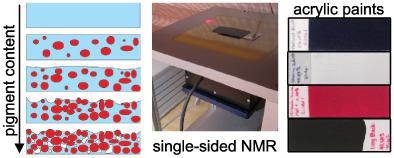当前位置:
X-MOL 学术
›
Magn. Reson. Chem.
›
论文详情
Our official English website, www.x-mol.net, welcomes your
feedback! (Note: you will need to create a separate account there.)
Effect of pigment concentration on NMR relaxometry in acrylic paints
Magnetic Resonance in Chemistry ( IF 1.9 ) Pub Date : 2020-06-15 , DOI: 10.1002/mrc.5053 Mary Rooney 1 , Tyler Meldrum 2
Magnetic Resonance in Chemistry ( IF 1.9 ) Pub Date : 2020-06-15 , DOI: 10.1002/mrc.5053 Mary Rooney 1 , Tyler Meldrum 2
Affiliation

|
Acrylic emulsion paint is among the most common media employed by 20th century artists. Since early acrylic paintings have begun to require the attention of conservators, scientists are working to characterize the properties of these paints to facilitate conservation efforts. In this study, we report an investigation of the physical and chemical properties of acrylic emulsion paints using single-sided NMR in conjunction with gloss measurements and scanning electron microscopy-energy dispersive spectrometry. Combining the data from these techniques gives insight into pigment-base interactions and the acrylic curing process, showing that as pigment concentration is increased in paints, the amount of acrylic base adsorbed to pigment particles increases, resulting in films with differing relaxation times. This research both emphasizes and contextualizes the utility of NMR relaxometry in studying cultural heritage objects, and prompts further study into the effects of pigment concentration on the curing and conservation of paint films.
中文翻译:

颜料浓度对丙烯酸涂料中核磁共振弛豫的影响
丙烯酸乳胶漆是 20 世纪艺术家最常用的媒介之一。由于早期的丙烯酸绘画开始需要保护人员的关注,科学家们正在努力表征这些油漆的特性,以促进保护工作。在这项研究中,我们报告了使用单面核磁共振结合光泽度测量和扫描电子显微镜 - 能量色散光谱法对丙烯酸乳液涂料的物理和化学性质进行的调查。结合这些技术的数据,可以深入了解颜料-基相互作用和丙烯酸固化过程,表明随着涂料中颜料浓度的增加,吸附在颜料颗粒上的丙烯酸基的量增加,导致薄膜具有不同的弛豫时间。
更新日期:2020-06-15
中文翻译:

颜料浓度对丙烯酸涂料中核磁共振弛豫的影响
丙烯酸乳胶漆是 20 世纪艺术家最常用的媒介之一。由于早期的丙烯酸绘画开始需要保护人员的关注,科学家们正在努力表征这些油漆的特性,以促进保护工作。在这项研究中,我们报告了使用单面核磁共振结合光泽度测量和扫描电子显微镜 - 能量色散光谱法对丙烯酸乳液涂料的物理和化学性质进行的调查。结合这些技术的数据,可以深入了解颜料-基相互作用和丙烯酸固化过程,表明随着涂料中颜料浓度的增加,吸附在颜料颗粒上的丙烯酸基的量增加,导致薄膜具有不同的弛豫时间。











































 京公网安备 11010802027423号
京公网安备 11010802027423号